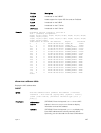
dynamic (OPTIONAL) Enter the keyword dynamic to allow aging of
MACs even though a learning limit is configured.
station-move-
violation
(OPTIONAL) Enter the keywords station-move to allow a
station move on learned MAC addresses.
Defaults
• On S-Series, the default behavior is dynamic.
NOTE: “Static” means manually entered addresses, which do not age.
Command
Modes
INTERFACE
Command
History
This guide is platform-specific. For command information about other platforms,
refer to the relevant Dell Networking OS Command Line Reference Guide.
The following is a list of the Dell Networking OS version history for this command.
Version Description
9.7(0.0) Introduced on the S6000-ON.
9.0.2.0 Introduced on the S6000.
8.3.19.0 Introduced on the S4820T.
8.3.11.1 Introduced on the Z9000.
8.3.12.0 Deprecated the no-station-move command (replaced by
the mac-learning-limit mac-address-sticky
command).
8.3.7.0 Introduced on the S4810.
8.3.1.0 Added the vlan option on the E-Series.
8.2.1.0 Introduced on the S-Series.
7.7.1.0 Introduced on the C-Series. Added the station-move
option.
6.5.1.0 Added support for MAC Learning-Limit on the LAG.
Usage
Information
This command and its options are supported on physical interfaces, static LAGs,
LACP LAGs, and VLANs.
If you do not specify the vlan option, the MAC address counters are not VLAN-
based. That is, the sum of the addresses learned on all VLANs (not having any
learning limit configuration) is counted against the MAC learning limit.
MAC Learning Limit violation logs and actions are not available on a per-VLAN
basis.
With the keyword no-station-move option, MAC addresses learned through this
feature on the selected interface persist on a per-VLAN basis, even if received on
1110
Layer 2


















